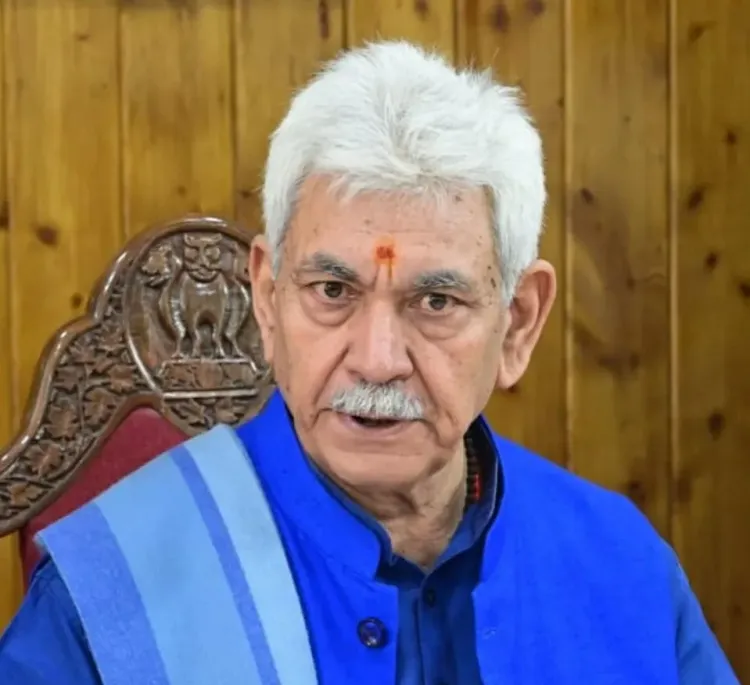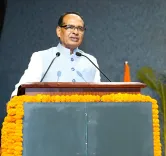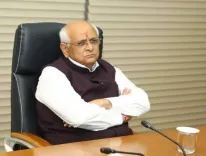What Decisions Were Made in the 75th Meeting of Shri Mata Vaishno Devi Shrine Board?

Synopsis
Key Takeaways
- Significant infrastructure projects are underway to improve the pilgrim experience.
- A new helipad is planned to facilitate travel.
- The Board is focusing on renewable energy initiatives.
- Enhanced security measures have been implemented.
- The Yatri Feedback System will be expanded for continuous service improvement.
Jammu, June 24 (NationPress) The Lieutenant Governor of J&K, Manoj Sinha, presided over the 75th meeting of the Shri Mata Vaishno Devi Shrine Board (SMVDSB) on Tuesday, during which several resolutions were made to enhance facilities at the revered shrine.
The Board made significant decisions regarding both ongoing and new projects, including the construction of the Exit Track and the remodeling of the Manokamna area at Bhawan. Additional developments include a new helipad in Katra, the New Vaishnavi Bhawan, cottages near the Sports Stadium in Katra, and the widening of the yatra track from Sanjichhat to Bhawan. Furthermore, the operationalization of the Board's Medical College at Kakryal was discussed, along with other initiatives aimed at improving services for pilgrims.
The meeting also evaluated the current status of the new helipad project in Village Hutt, a collaborative endeavor with the Shri Shiv Khori Shrine Board, managed by the Border Roads Organisation (BRO). The Board expressed serious concern over delays and revisions, directing BRO to complete the project by October 2025.
Additionally, progress on renewable solar energy initiatives within the Shrine area was reviewed, with instructions given to the CEO of SMVDSB to devise a comprehensive plan for critical installations aimed at reducing the carbon footprint.
The Board approved a thorough sewerage network that covers 100% of establishments within the Shrine area to boost sanitation infrastructure. The Lieutenant Governor also reviewed the Yatri Feedback System, directing its expansion to encompass all services, with monthly monitoring and proactive encouragement of pilgrim participation to ensure continuous service improvement.
Moreover, the Board instructed the CEO of SMVDSB to investigate the feasibility of utilizing volunteer services to assist pilgrims by addressing their inquiries and providing guidance along the Yatra route, thereby enhancing their overall experience during the pilgrimage.
The Board congratulated the elevation of security measures in the Shrine area, marked by the inauguration of an Integrated Command and Control Centre at SGC, Katra, alongside seven Sub-Control Centres, which were established with the support of the Lieutenant Governor. Advanced security equipment was also provided to security agencies to ensure robust security and real-time crowd management, prioritizing the safety of devotees.
In a significant move, the Board sanctioned the dedication of five temples built in Reasi District to the public in July 2025 and approved the construction of five new temples, emphasizing uniform architectural design across all locations to reflect the Shrine Board's heritage and aesthetic standards.
The Board also assessed and approved financial assistance for institutions under the SMVD Charitable Society, which includes the Gurukul, hospital, sports complex, college of nursing, and medical college, supporting their operations through grants-in-aid. During the meeting, the Lieutenant Governor inaugurated numerous pilgrim-centric facilities, such as a Battery Car Parking stand, Outer Cave Shed, Self-Service Kiosk/Digital Cash Register, and Smart Lockers.
Significant infrastructure projects initiated by the Shrine Board aim to enhance the pilgrim experience. A Battery Car Parking stand at Bhawan was introduced to provide convenience, especially for elderly and disabled pilgrims. The basement, covering about 1000 sqft, serves as a storage area for materials from the Material Ropeway. Additionally, a laminated glass shed outside the Cave area was fabricated to ensure smooth pilgrimage regulation in all weather while preserving the area's natural beauty.
Three hundred smart lockers located near the Skywalk area at Bhawan were also dedicated for devotee use, providing a convenient and secure storage solution linked with RFID Cards for safe storage of belongings.
Furthermore, the Lieutenant Governor inaugurated an additional dormitory block at SMVD Gurukul, constructed at a cost of Rs 71.82 lakh, which accommodates an additional 32 students, thereby enhancing the institution's capacity and infrastructure to cater to the growing student population.








